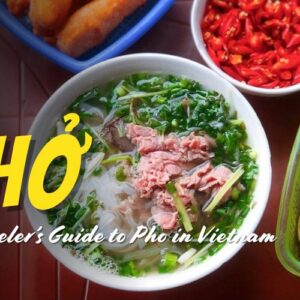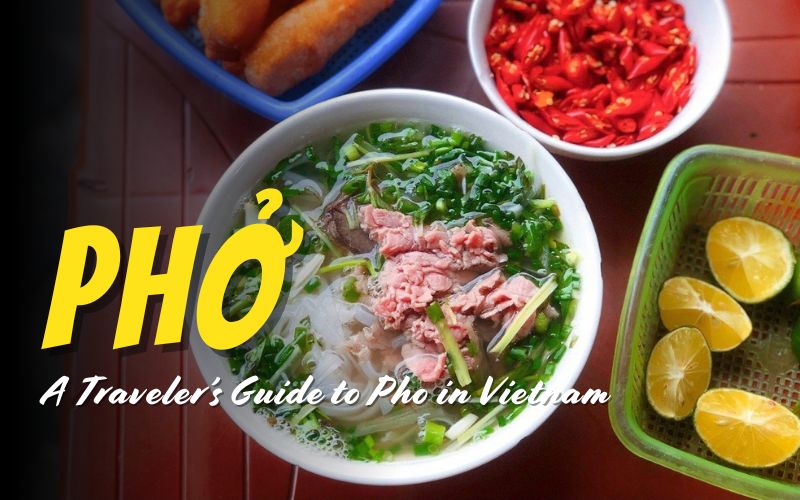
Imagine you have just landed in Vietnam one early morning. On the small foggy street, you walk into a casual restaurant, where the smell of the aroma of pho broth rises, fragrant with cinnamon, star anise, and grilled ginger. A hot bowl of pho is served; smooth white noodles and lightly pink slices of beef and a few green onions stand out against the clear broth. You take the first spoonful; the sweet taste spreads, strangely warming your heart. Trust me, there is nothing better than starting your day with a bowl of pho in Vietnam—the soul of Vietnamese cuisine.
The History of Pho
When you think of Vietnamese food, pho may be the first name that comes to your mind. But do you know that this national dish also contains an interesting historical story, which profoundly reflects the culture and spirit of the Vietnamese?
It was born in the early 20th century and is thought to have originated in the northern plain, especially in Hanoi and Nam Dinh (now merged to Ninh Binh). There are many theories about the origin of pho, but the most common one is the intersection between Chinese cuisine (with the dish “nguu nhuc ”phan”—beef noodles) and the influence of the French during the colonial period (with the dish pot-au-feu—beef bone stew). From this combination, the Vietnamese created pho, a dish with unique flavour and exquisite and rich East Asian flavour.
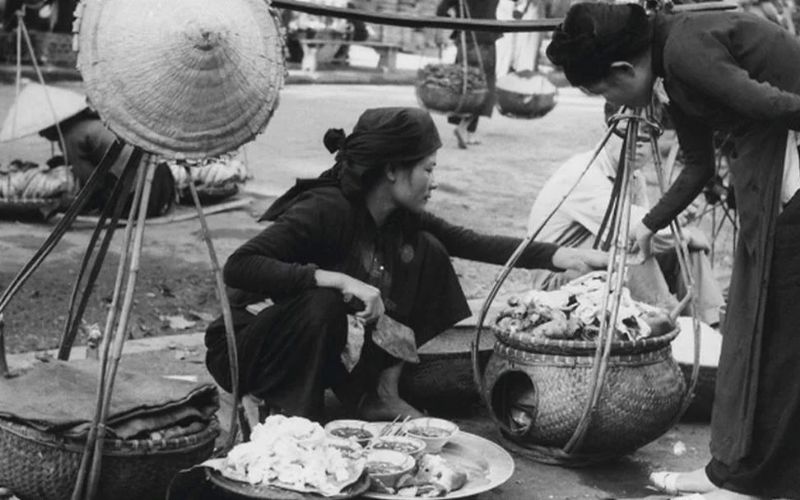
The origin of Pho
At first glance, pho seems simple: just bread (thin rice), water, and beef or chicken, but the broth itself, preserved from cow bones and added cinnamon, salmon, ginger, and onion for many hours, is the soul of this dish. Each organ is a symbol of aroma and taste, both light and intense.
For Vietnamese people, pho is not only a popular breakfast but also a memory and a national pride. You can find breakfast on every corner, from roadside bars to upscale restaurants. And each region has its own way of tasting, changing its tone: Hanoi pho is standard taste, and Saigon pho has sweeter soup, eaten with rich live vegetables.
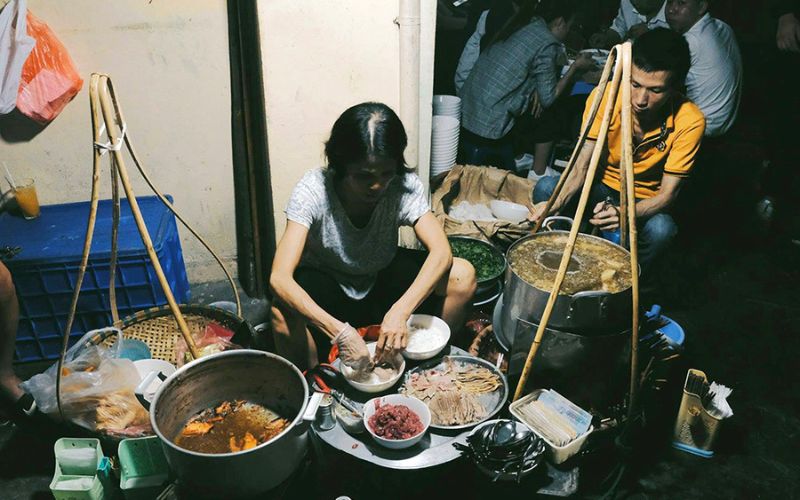
“Pho gánh” on street vendor
Today, pho has crossed the border of Vietnam, becoming an ambassador of culinary culture worldwide. But perhaps, it’s better to enjoy a bowl of hot soup on a cold morning in Hanoi or a warm evening in the heart of Saigon, where you feel the soul and the love of this S-shaped country in every spoon of pho.
Popular Types of Pho You Must Try when Visiting Vietnam
Pho bo (beef pho)
If only one dish could be chosen to represent Vietnamese cuisine, beef pho would definitely be the number one candidate. Not only famous domestically, but also internationally, beef pho has become a symbol of Vietnamese cuisine in the world, appearing in many big cities such as Paris, Tokyo, New York, and Sydney.
The broth is the most quintessential part. Simmered from beef bones for many hours and combined with traditional spices such as cinnamon, star anise, grilled ginger, and grilled onions, beef pho broth has a strong aroma and a sweet, rich taste without being greasy. Each bowl of pho is the result of patience and dedication. The beef is carefully selected; you can order rare beef (medium when poured with broth), well-done beef, flank (soft and fatty tendon), or combine many types depending on your taste. Pho noodles, which are soft, thin white rice noodles, are blanched in boiling water and placed in a bowl before the broth is poured over.
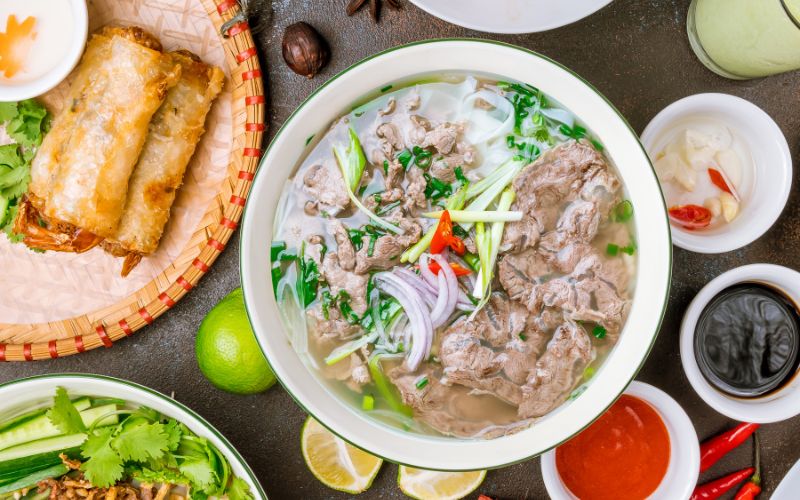
Pho bo (beef pho)
Pho ga (chicken pho)
Pho ga has its own charm, delicate and gentle like the Vietnamese personality. This is the ideal choice for those who want to experience pho but are not used to eating red meat or want a lighter dish.
Pho ga broth is simmered from chicken bones and chicken skin, combined with ginger and grilled onions, creating a natural sweetness that is not too fatty. The chicken is usually a local chicken, a native with firm meat and yellow skin, boiled just enough to keep the sweetness and toughness.
Chicken pho can be served in two ways:
- Shredded chicken: the chicken is shredded and mixed with onions, Vietnamese coriander, and chicken fat.
- Whole chicken: for those who like to fully feel the sweet toughness of the meat.
Either way you enjoy it, a bowl of pho ga always brings a feeling of lightness and relaxation, like a warm hug on a cold morning.
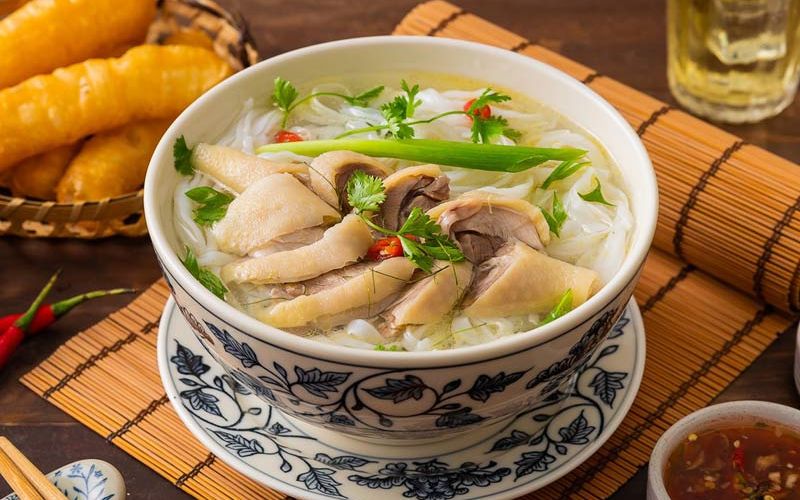
Pho ga (chicken pho)
>>> You want to discover Vietnam in a local way, not a hustle and famous tourist attractions? Reach out to our Authentic Vietnam in 13 Days Tour for more information.
Different Types of Pho Beyond Soup
Think pho can only be served with broth? So, your eyes (and palate) are about to be opened! In addition to the traditional pho soup, Vietnamese people have also created many interesting “non-soup versions” that are just as delicious: pho cuon, pho tron, and pho xao. Each with its own unique flavor, adding color to your culinary journey.
Pho cuon is a refreshing dish, loved on hot summer days in Hanoi. Instead of being blanched like traditional pho, thin rice noodles are used to wrap the filling inside, usually stir-fried beef with onions, raw vegetables, and cucumbers. After rolling, the dish is dipped in a sweet and sour fish sauce that is well-blended, salty, sour, sweet, and spicy. When you take a bite, you will feel the harmony between the rich meat flavour, cool herbs, and soft pho noodles.
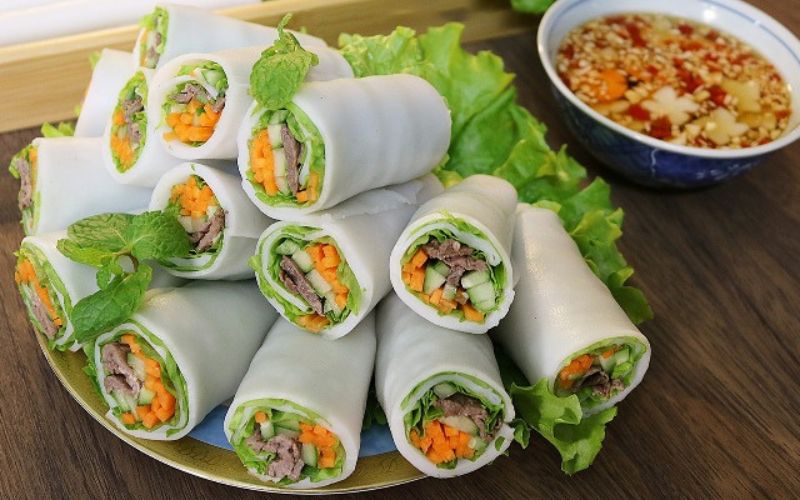
Pho cuon (rolled pho)
Pho tron (mixed pho)
Pho tron is the perfect choice for those who want to change taste or… have eaten too much pho broth during their trip. This dish consists of soft-boiled pho noodles mixed with beef (or chicken), herbs, fried onions, roasted peanuts, and most importantly, a special sauce.
In Vietnam, many places have pho tron, and each of them has a different way of mixing sauce. Some places tend to use fish sauce, garlic, and chilli; others use soy sauce mixed with vinegar, but the common point is that it is so delicious that you can’t stop using your chopsticks.
George, one of our customers, reviewed that he once visited a night market in Da Nang; he tried pho tron because of curiosity, but he unexpectedly turned out to be hooked. It’s cool, filling, and not too greasy. If you visit Vietnam, don’t forget to try pho tron!
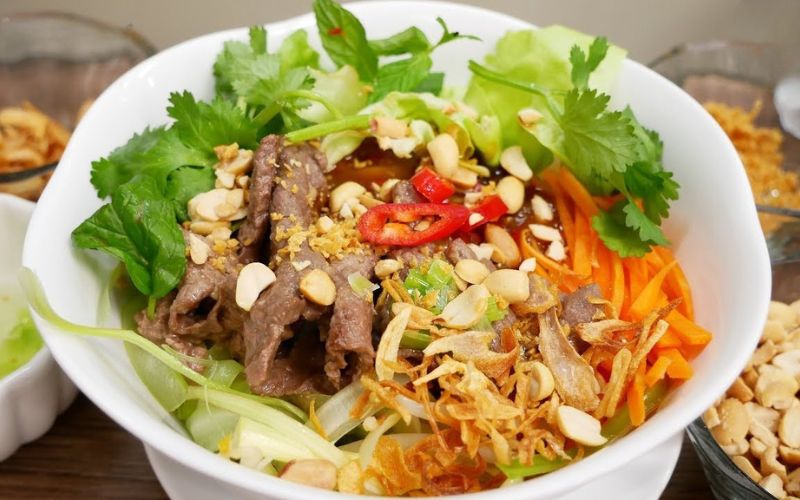
Pho tron (mixed pho)
Pho xao (stir-fried pho)
Pho xao is a typical Vietnamese street food: pho noodles are stir-fried in a large pan with beef, garlic, mustard greens, or onions. When stir-fried until golden brown, the pho noodles give off an attractive aroma, mixed with rich sauce, and are extremely delicious.
Some places also serve crispy stir-fried pho, which means the pho noodles are fried until crispy before being poured over the sauce; it makes a very pleasant crunch when biting into it!
Small suggestion: If you come to Ho Chi Minh City, try stir-fried pho at the night food stalls around Ben Thanh Market, an extremely popular “late night hunger fighting” dish.
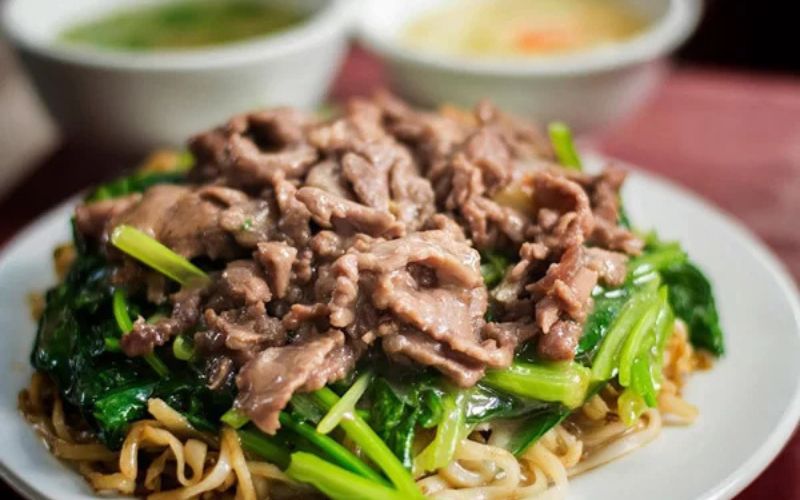
Pho xao (stir-fried pho)
How to Enjoy Vietnamese Pho properly?
Imagine you are sitting in front of a steaming bowl of pho, the aroma of beef, green onions, and broth mixed together. But don’t eat right away! Vietnamese people have a small “ritual” to enjoy pho properly and fully. Below are the steps to “eat pho like a local” that you should try at least once in your life.
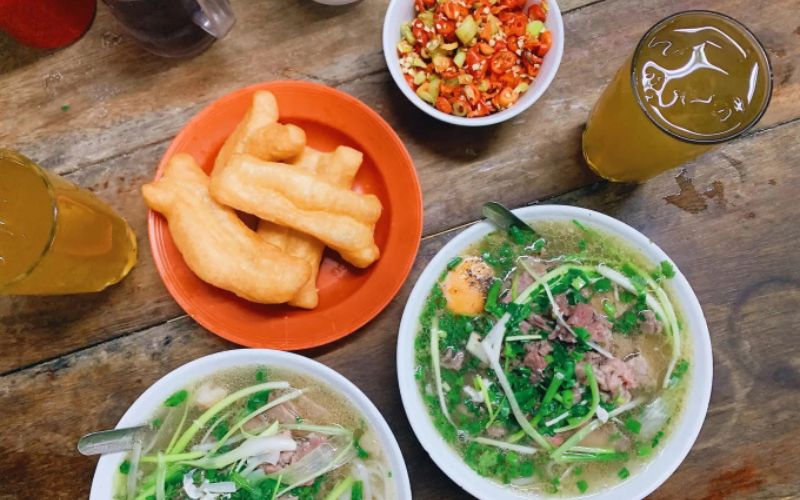
How to eat pho Viet properly
Step 1: Feel with your eyes and nose before touching your chopsticks
When pho is served, take a deep breath; you will smell the rich aroma of the broth. It is the scent of cinnamon, star anise, grilled ginger, onions… and the time it takes to simmer the bones for many hours. If you like taking pictures of food, this is the best moment! But don’t leave it too long, or the pho noodles will expand!
Step 2: Taste the flavor, but in order
In Vietnam, every table in pho restaurant has spices such as:
- Lemon (or kumquat): to increase the slight sourness, making the broth brighter.
- Garlic soaked in vinegar: very suitable for pho bo, helps to bring out the aroma.
- Chilli sauce and black sauce: often used in the south to dip meat or add to broth.
- Fresh chilli: add a little spiciness to stimulate the taste buds.
Note: Vietnamese people often taste the broth first, then slowly add spices. Don’t pour it all in at the beginning, because you might accidentally “ruin” the chef’s work of art!
Step 3: Eat the right kind of vegetables in each region
In the north, the fruit is usually not accompanied by raw vegetables, only onion leaves, spicy vegetables (chewing gum), and sometimes added gingerbread.
In the south, you will see a basket of raw vegetables: peas, cinnamon, onions, and spinach slowly dipped in and mixed before eating.
Step 4: Use the stick and spoon in the style of “double-edged sword”
Vietnamese people usually use a stick to cover bread and meat, combined with a spoon to boil water.
You can grab the meat, point it lightly into the dough, and eat it, then sip a tablespoon of water to feel the harmony. It sounds simple, but if you’ve ever seen a Vietnamese eat pho, you’ll realise it’s an art, not just a meal.
Step 5: Eat when it is hot!
It is best to eat pho when it is still smoking. Don’t let it cool before eating; the bread will boil, the meat will no longer be soft, and the water will lose its sweetness.
Are you ready to “eat pho like a Vietnamese”? When you understand how Vietnamese people enjoy pho, you are not just eating the food; you are touching a part of Vietnamese cultural identity. Try sitting at a roadside stall, ordering a bowl of rare beef pho, seasoned with some pickled garlic and fresh chilli. Then slowly enjoy each spoonful; you will see Vietnam appear in each flavour!
>>> Wanna uncover the beauty of Vietnam, from north to south in a short of time? Our Hanoi to Ho Chi Minh City Tour for a Glimpse of Vietnam in 8 Days to make your dream escape come true!
Where to Eat the Best Pho in Vietnam?
When you set foot in Vietnam, whether you start your journey in Hanoi, stop in Hue or end in bustling Ho Chi Minh City, a hot bowl of pho in the morning is an experience you should not miss. And if you want to enjoy pho like a true local, you need to find long-standing addresses, places that preserve traditional flavours and have been trusted by locals for decades. Below are 6 famous pho restaurants in three major cities, not only impressing Vietnamese people but also recognised or nominated by the Michelin Guide, guaranteeing the top quality and flavour.
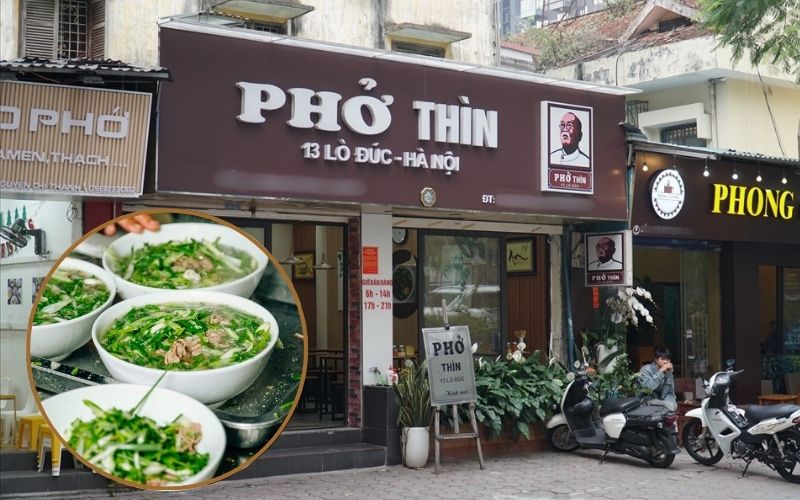
Pho Thin Lo Duc
- Pho Thin Lo Duc (13 Lo Duc, Hai Ba Trung, Hanoi, Vietnam): One of the most “memorable” pho restaurants in the capital. Pho Thin stands out with its special rare beef style. Beef is stir-fried with garlic before being poured over the broth, bringing a richer, more aromatic flavour than the traditional northern pho style. The broth is light and thick, and the pho noodles are soft and fragrant with fresh onions. The restaurant has been named by the Michelin Guide in the Bib Gourmand category for delicious dishes at reasonable prices. And you should note that the restaurant is very crowded during peak hours in the early morning, but the experience of waiting in line for pho is also an interesting part of the culinary journey!
- Pho Bat Dan (49 Bat Dan, Hoan Kiem, Hanoi): A “classic” place for those who want to taste the authentic northern pho flavour. The broth is clear, light, and fragrant with grilled ginger and cinnamon, simmered from beef bones for many hours. The rare beef is soft and sweet, served with crispy fried breadsticks, the true style of the old Hanoians. Pho Bat Dan is also a name that is regularly nominated in the list of excellent pho restaurants by Michelin and prestigious travel publications. We recommend you to come early and prepare to “queue for self-service”—a ”special cultural feature only available here.
- Pho Lac Thien (65 Dinh Tien Hoang, Hue City): This restaurant is famous for its mussel rice and beef noodle soup. You can still find a delicious bowl of pho. Pho Lac Thien serves northern-style beef pho, but the flavours are adjusted to suit Hue’s taste: less fat, lighter broth, tender beef, and fresh herbs. The restaurant space is simple, close to attractions such as the Imperial City, and very convenient for tourists to stop for breakfast.
- Pho Tung (1A Nguyen Cong Tru, Hue City): If you love lightness and want to try traditional chicken pho, Pho Tung is an option not to be missed. The bowl of pho here has clear broth, natural sweetness from chicken bones, and delicious boiled chicken. The space is airy and clean, and the service is fast, very suitable for a quiet morning in this poetic city.
- Pho Vietnam (14 Pham Hong Thai, District 1, Ho Chi Minh City): This is the first pho restaurant in Saigon to be honoured by the Michelin Guide with the Bib Gourmand 2024 rating. The pho here is special with its presentation in a heat-retaining stone pot, fresh homemade pho noodles every day, and a variety of beef from brisket, tendon, and flank to baby back ribs. Many tourist came here to enjoy the rich flavour, attentive service, and being open almost 24/7, ideal for hungry night owls after a night of exploring Bui Vien Street.
- Pho Hoa Pasteur (260C Pasteur, District 3, Ho Chi Minh City): Although no longer on the Michelin Guide 2025 list, Pho Hoa is still a “must-try” address for international tourists when coming to Ho Chi Minh City. With spacious, clean space and professional service, Pho Hoa serves beef and chicken pho with fresh vegetables, black bean sauce, and Saigon-style chilli sauce, making it an indispensable destination on the culinary tour of Ho Chi Minh City.
>>> Are you a foodie and want to taste mouth-watering Vietnamese cuisine? Visit Top 9 Michelin-starred Restautants in Vietnam 2025 for famous awarded restaurants, which offers Vietnamese rich culinary culture.
In conclusion, from small street pho restaurants in Hanoi to a steaming bowl of pho in a stone pot in the heart of Ho Chi Minh City, pho is more than just a dish; it’s a vibrant cultural experience, reflecting the hospitality, culinary sophistication, and daily life of the Vietnamese people. Whether you choose rich pho bo, refreshing pho ga, or enjoy variations such as pho cuon, pho tron, and pho xao, each choice opens a door to the heart of Vietnamese cuisine. So, what are you waiting for? Contact us to plan your amazing holiday to Vietnam and enjoy the steaming bowl of pho now!
Read more:
